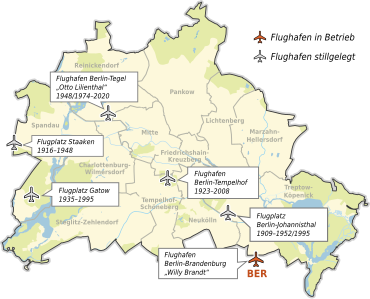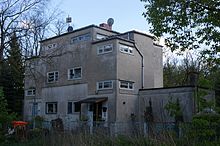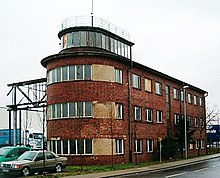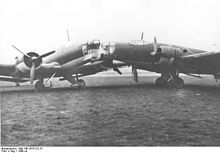Staaken airfield

The Staaken airfield in Berlin-Staaken on Brunsbütteler Damm developed over the course of its 40-year history (1915–1953) from a Zeppelin factory yard to one of the first commercial airports in Germany in the 1920s and finally to the main shipyard of what was then Deutsche Lufthansa AG . Judging by the large number of factory and transfer flights from the mid-1930s onwards, Staaken airfield corresponded to a major airport by the standards of the time, albeit with the peculiarity that Lufthansa passenger traffic in Berlin had been handled exclusively at Tempelhof central airport since the 1930s . This peculiarity led to the fact that the Staaken airfield was very quickly no longer in the public eye after the Zeppelin era in the 1920s, so that after its closure at the end of 1953 it was almost forgotten. At the same time, this shadowy existence was a welcome opportunity for the air forces of both the Reichswehr and later also the Wehrmacht to develop and test military aviation technology on a large scale but initially unnoticed by the public under the pretext of civilian purposes (e.g. flight training). The main shipyard of what was then Lufthansa there was also largely used as a repair and research facility for the Luftwaffe until the end of World War II , camouflaged as a purely civilian operation until February 1935.
Initial phase (1915-1919)


After the first military airfield of the air forces of the German Empire was set up in neighboring Döberitz at the beginning of 1910 , Luftschiffbau Zeppelin GmbH acquired a site in Staaken on July 9, 1915 in order to be able to manufacture airships with military orientation in accordance with an order from the War Ministry . The existing plants in Friedrichshafen , Potsdam and Gotha could not meet the needs of the military. As was customary for general work in the First World War with the Triple Entente and the Central Powers , Russian prisoners of war were used to drain the swampy terrain. They were interned in a camp in the northern part of the neighboring garden town of Staaken on today's Ungewitterweg (called "Russenweg" until 1935). On November 9, 1916, the first airship left the Staakener shipyard. A total of twelve zeppelins were built in Staaken by the end of the First World War.
In addition, during the First World War, nine of a total of 18 so-called giant aircraft of the Zeppelin (Staaken) R.VI type were built in the Zeppelin plant in Staaken from 1915 , which were used as strategic bombers, especially over London . These so-called "Staaken giant aircraft" are among the largest series-built double-deckers in aviation history.
Due to the armistice signed on November 11, 1918 and subsequently negotiated peace treaty , Germany was no longer allowed to produce airships and aircraft, so production in Staaken had to be stopped. The area, which had meanwhile been converted into an airfield, was still used for civil purposes.
From August 20, 1919, a Zeppelin line service was set up with the LZ 120 between Friedrichshafen and Berlin-Staaken , whereby six hours were needed to cover the approximately 600-kilometer flight route and 20 passengers could fly. After 103 trips, the connection was closed again on December 5, 1919. Zeppelins in Atlantic traffic only used Staaken airfield occasionally.
1920s



In 1922 the Deutsche Luft-Reederei (DLR) moved from the Johannisthal airfield in Berlin to its new home airfield in Staaken. DLR, founded in 1917 with the internationally known crane logo of what would later become Lufthansa, was the first German airline and - like Deutsche Aero Lloyd AG, founded in Staaken in 1923 - one of the predecessor companies of Lufthansa, initially founded in 1926 under the company name Deutsche Luft Hansa AG . On December 27, 1922, DLR started Germany's first international airline service with London , but the Berlin-Tempelhof central airport soon proved to be more conveniently located for passenger air traffic.
On April 1, 1925, the German Aviation School (DVS) was founded at Staaken airfield (its headquarters were relocated to Braunschweig - Broitzem in 1929 ). Contrary to the official name, the German Air Traffic Aviation Schools emerging at various locations in the German Reich were camouflaged training centers and flying units of the military aviation prohibited by the Versailles Treaty , financed through secret channels of the German government, the Reichsmarine and the Reichswehr . Especially for members of the DVS 1925 on the high road , the Neu-Jerusalem completed a total area of 37,611 sqm with. The tower , also completed in 1925, popularly known as the “Zeppelin Tower” in Berlin , has been expanded and renovated as a private company headquarters since 2015.
Private flight schools at Staaken airfield trained a number of well-known personalities to become pilots, including Wernher von Braun , Heinz Rühmann , Elli Beinhorn , Marga von Etzdorf and Hanna Reitsch .
In 1929, the airfield was sold to the city of Berlin, although it could still be used by civil aviation. So who graduated Lufthansa above all training flights and used the halls for maintenance. The Challenge aviation competitions were held in Staaken in 1930 and 1932 , as the German aviator Fritz Morzik had won the Challenge in 1929 and 1930.
Development during the Nazi era (1933–1945)
In the period from 1933 to 1945, Staaken airfield advanced to become the main location of what was then Lufthansa Technik , so that in terms of infrastructure and flight movements it was a major airport by the standards of the time. State guests were sometimes received in Staaken, such as Joseph Vuillemin , head of the French Armée de l'air , who was welcomed by Aviation Minister Hermann Göring on August 16, 1938 on the occasion of his two-day visit .
New weapon branch of the Wehrmacht Luftwaffe
After secret services of the victorious powers the forbidden existence of the branch of Air Force of the Armed Forces had spied out, beat Great Britain and France on February 3, 1935. a trilateral air pact with Germany that the Nazi regime consented on February 16 1935th In the course of the talks, the existence of the air force was admitted and henceforth tolerated by Great Britain and France. The cause and background of this air pact with mutual assistance in the event of an air strike was primarily the concern of Great Britain with regard to the actual clout of the air forces of both France, which had previously been superior in terms of aeronautical technology, and the ambitious Nazi regime. In Staaken, on March 14, 1935 , Hitler officially presented the new Luftwaffe , officially founded on March 1, 1935, to the public for the first time. For this purpose, the machines of the “Jagdgeschwader Richthofen” of the type Arado Ar 65 were installed as the first unit of the new air force on the southern part of the Staaken airfield in front of the tower from the 1920s.
Charles Lindbergh in Staaken
On July 22, 1936 aviation pioneer Charles Lindbergh landed with his wife Anne Morrow Lindbergh (also aviation pioneer) in the two-seater Miles Whitney Straight with pilot and co-pilot function borrowed from the British Royal Air Force at Staaken airfield, from there in his function as Colonel of the US Army Air Corps to begin its first inspection trip in Germany with a visit to the "Richthofen Jagdgeschwader" stationed temporarily in Staaken. The trip was arranged by the US military attaché Truman Smith of the US embassy in Berlin with the intention of being able to find out more information about the effectiveness of the German air force, not least from Hermann Göring himself. Lindbergh landed again, meanwhile promoted to Brigadier General, on the occasion of another visit by the Reich government on October 19, 1938 in Staaken.
Flight records
During the 1936 Summer Olympics , gliding was added to the program as a demonstration sport. The flight events, including aerobatics, took place on August 4, 1936 from Staaken airfield. The Swiss pilot Hermann Schreiber, who also took part, was also awarded a gold medal for a glider flight over the Alps.
On August 10, 1938, Lufthansa's Fw 200 V1 “Condor” D-ACON was the first land-based passenger aircraft (with additional tanks) to fly the 6371-kilometer non-stop route from Berlin-Staaken to Floyd Bennett Field in New York in 24 hours, 56 minutes and 12 seconds (this corresponds to an average speed of 255.499 km / h ). On the return flight from Floyd Bennett Field to Berlin-Tempelhof , the machine covered a distance of 6392 kilometers in 19 hours and 55 minutes. This corresponded to an average speed of 321 km / h. Both flights were recognized by the FAI as flight path records, category 2 (record with crew).
Long-range reconnaissance troop Luftbild GmbH

In the mid-1930s, a long-range reconnaissance troop disguised with the code name Luftbild GmbH was relocated to Staaken. This was commissioned to photograph border fortifications of neighboring countries over German territory. Initially equipped with a Junkers W 34 , it carried out reconnaissance flights at great heights on the border with France and over the then German areas on the border with Poland and what was then Czechoslovakia . In the course of 1936 the troop, now disguised as a department of Hansa Luftbild GmbH , was upgraded to five machines. In the summer she received a Junkers Ju 86 V9 specially equipped for aerial reconnaissance with the latest camera technology at the time , which enabled long-distance reconnaissance over the Soviet Union from the Finnish bay to the Soviet interior. In late autumn 1936, the first of three Heinkel He 111 C-03s from Lufthansa was added. Now disguised as Lufthansa commercial aircraft, reconnaissance flights were carried out over Great Britain and France from 1937 at the latest. In January 1939, the long-range reconnaissance troop was placed under direct orders from Göring as the “reconnaissance group Ob.dL” (Commander in Chief of the Air Force). In the spring of 1939 she was equipped with three new Focke-Wulf Fw 200s , including the “Nordmark” of Lufthansa and the B version, which was also intended for Lufthansa, an improved type u. a. with double chassis. In the run-up to the attack on Poland on September 1, 1939, aerial reconnaissance over Poland began in early May 1939, and Wilhelm Canaris , head of the so-called Abwehr , was also involved in the planning .
Forced labor for the Lufthansa shipyard and the Junkers engine warehouse
As the situation on the civilian labor market became increasingly precarious due to conscription to the armed forces, Lufthansa also employed more and more forced laborers. Of at least 10,000 forced laborers from Russia and the Ukraine employed by Lufthansa, the majority were exploited in the Lufthansa shipyard in Staaken, including a large number of children and young people. With completely inadequate nutrition and frequent mistreatment, these forced laborers were housed at the southern entrance to the airfield on Schulstrasse. The children and adolescents from this camp had to crawl into narrow cavities in the wings of the Lufthansa shipyard, where adults could not get to do riveting work. In this way, time-consuming dismantling of the wings was avoided under inhuman and dangerous working conditions.
When many airfields in Germany had to close for economic reasons, at the same time decentralized spare parts and equipment for smaller aircraft checks were relocated back to the central warehouse in Staaken, so that storage capacities at Staaken airfield quickly reached their limits. At the beginning of the 1940s, another site was rented around 3 km to the west next to the Berlin - Hanover railway line, on which, among other things, a 1,500 m² arched roof hall was built by Junkers in 1941 to store Junkers aircraft engines and used by Lufthansa. The camp for the mostly Polish forced laborers who were exploited there was built next to this Junkers hall. It consisted of five residential barracks, mostly made of solid stone, for 54 people each, as well as three barracks for supply and sanitary facilities.
End of war and post-war period
At the end of the Second World War , the area was occupied by units of the 1st Belarusian Front on April 26, 1945 and was used as an airfield by fighter units of the Soviet Air Force until the end of the fighting . During the Potsdam Conference Staaken served as a landing place for the delegations of the participants and courier flights taking place in this context. Even after the war ended, the site was used as a base for various hunting, transport and attack aircraft units. This is documented, among other things, by an airplane accident on April 5, 1948 between a Vickers Viking of the BEA , which was en route to Gatow airfield , and a Jak-3 of the Soviet Army , which wanted to land in Staaken. The flying formations were withdrawn in 1953, but the area was not placed under German administration until 1957 and the airfield closed. In 1958 the former barracks building was converted into a hospital. On the rest of the site, steel was stored and at times also used as a vehicle depot by the Eisenach automobile plant.
Today's traces of the past
Even today, individual airfield buildings in the southern part of the former airfield (including the tower and hangars ) as well as the administration buildings of the former Zeppelin works and, for the most part, the runway system, which can be easily recognized from the air due to the asphalt and concrete remains, and the compensation disc are more or less well preserved . The large arched warehouse built by Junkers in 1941 and used by Lufthansa for the storage of large parts, along with the remains of the forced labor barracks there, still exist today. However, these historic airfield properties are only accessible to a limited extent as they are largely private property. Between 1958 and 1997, some of the now largely empty buildings of the former air barracks were used for the Nauen district hospital. The runway on the airfield was used by businesses as a storage area for industrial building materials.
literature
- Rainer W. During: Staaken Airfield - A piece of aviation history. Erich Lezinsky Verlag, 1985, ISBN 3-925181-01-6 .
- Uwe Mehlitz: Giant cigars and silver cranes over Berlin: the Staaken airship and airport - an important place in aviation history. Kindle Edition, 2017.
Individual evidence
- ↑ a b c d e f g h i Uwe Mehlitz: Giant cigars and silver cranes over Berlin: The Staaken airship and airport - an important place in aviation history. Kindle Edition, 2017.
- ^ Stephan Prager: Organizations after the First World War. in other words: German aerial photography. West German Verlag, Cologne / Opladen 1961, DNB 458782254 , pp. 18-21.
- ^ Dirk Richhardt: Selection and training of young officers 1930–1945. On the social genesis of the German officer corps. Dissertation. Department of History and Cultural Studies at the Philipps University of Marburg , 2002.
- ↑ Dieter Jung, Berndt Wenzel, Arno Abendroth: The ships and boats of the German sea pilots. Motorbuch Verlag, Stuttgart 1977, ISBN 3-87943-469-7 , pp. 47, 57, 107, 110 and 394.
- ↑ A Nazi Order for Charles Lindbergh. In: Der Tagesspiegel. February 3, 2002. (tagesspiegel.de)
- ^ Charles Lindbergh. in the online encyclopedia "Spartacus Educational". (spartacus-educational.com accessed October 6, 2018)
- ^ "Condor" record flights Berlin - New York - Berlin, Deutsche Lufthansa AG, Cologne, company archive
- ↑ see also J. Richard Smith, Eddie J. Creek, Peter Petrick: Secret flights: Der Versuchsverband des Oberkommandos der Luftwaffe 1939-1945.
- ^ Accident. (No longer available online.) Archived from the original on July 21, 2009 ; Retrieved August 21, 2009 .
- ^ Stefan Büttner (Ed. Lutz Freundt): Red places. Russian military airfields Germany 1945–1994. Air bases – aerodromes – military fallow areas. AeroLit, Berlin 2007, ISBN 978-3-935525-11-4 , pp. 110/111.
Coordinates: 52 ° 31 '58.6 " N , 13 ° 7' 45.2" E





